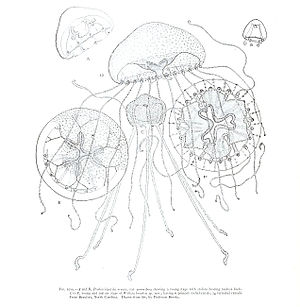Proboscidactylidae
| Proboscidactylidae | ||||||||||||
|---|---|---|---|---|---|---|---|---|---|---|---|---|

Proboscidactyla ornata and Proboscidactyla brooksii , illustration |
||||||||||||
| Systematics | ||||||||||||
|
||||||||||||
| Scientific name | ||||||||||||
| Proboscidactylidae | ||||||||||||
| Hand & Hendrickson , 1950 |
The Proboscidactylidae are a family of the Hydrozoa (Hydrozoa). The family currently includes about twelve species.
features
The hydroid polyps live sessile, the hydrorhiza is formed by crawling, naked stolons. The hydrants are polymorphic. The feeding polyps have a rounded cone of the mouth (hypostome) inclined away from the tentacles, which is set off from the body by a constriction. The upper end of the cone of the mouth is occupied by groups of nettle cells, which are also slightly off one side. The actual mouth sits on the side of the mouth cone. Below the constriction, two filiform tentacles sit roughly opposite the groups of nettle cells or the outwardly inclined mouth cone. Sexual polyps and military polyps are without tentacles and without a mouth. They are significantly smaller than the feeding polyps. The Medusa buds are formed at the tip of the sexual polyps. The free- living medusas are mostly hemispherical. The manubrium has four to six, sometimes more radial, gastric pouches that extend proximally along the radial channels. The gonads surround the manubrium and extend to the gastric pouches. The radial channels are branched, sometimes they are also receding. There is no ring canal, but a gastrodermal ring. The marginal tentacles are hollow with a thickened base connected to the lumen of the radial channels. On the outer screen, numerous clusters or ribbons of nettle cells alternate with the tentacles. The cnidoma of hydropolypes and medusa has macro- and microbasic euryteles and desmonemes. There are no ocelli or statocysts present. The medusae can in turn produce medusae asexually by budding.
Geographical occurrence and way of life
The animals live as epizoa on the upper edge of the tubes of featherworms (Sabellidae). They are common worldwide.
Systematics
According to the "World Hydrozoa Database", the family includes two genera:
- Fabienna Schuchert, 1996
- Proboscidactyla Brandt, 1834 ( syn.Lar Gosse, 1857)
swell
literature
- Marymegan Daly, Mercer R. Brugler, Paulyn Cartwright, Allen G. Collin, Michael N. Dawson, Daphne G. Fautin, Scott C. France, Catherine S. McFadden, Dennis M. Opresko, Estefania Rodriguez, Sandra L. Romano & Joel L. Stake: The phylum Cnidaria: A review of phylogenetic patterns and diversity 300 years after Linnaeus. Zootaxa, 1668: 127-182, Wellington 2007 ISSN 1175-5326 Abstract - PDF
- Paul Lassenius Kramp: Synopsis of the medusae of the world. Journal of the Marine Biological Association of the United Kingdom, 40: 1-469, Plymouth 1961 [1] (download of individual chapters or the entire work = 130 MB!).
On-line
Individual evidence
- ↑ a b World Hydrozoa Database
- ^ Jean Bouillon and Fernando Boero: Synopsis of the families and genera of the hydromedusae of the world, with a list of worldwide species. Thalassia Salentina, 24, 47-296, Galatina 2000 ISSN 0563-3745 PDF
- ↑ Mariko Kawamura and Shin Kubota: Influences of temperature and salinity on asexual budding by hydromedusa Proboscidactyla ornata (Cnidaria: Hydrozoa: Proboscidactylidae). Journal of the Marine Biological Association of the United Kingdom, 88: 1601-1606 Cambridge University Press 2008 doi : 10.1017 / S0025315408002944